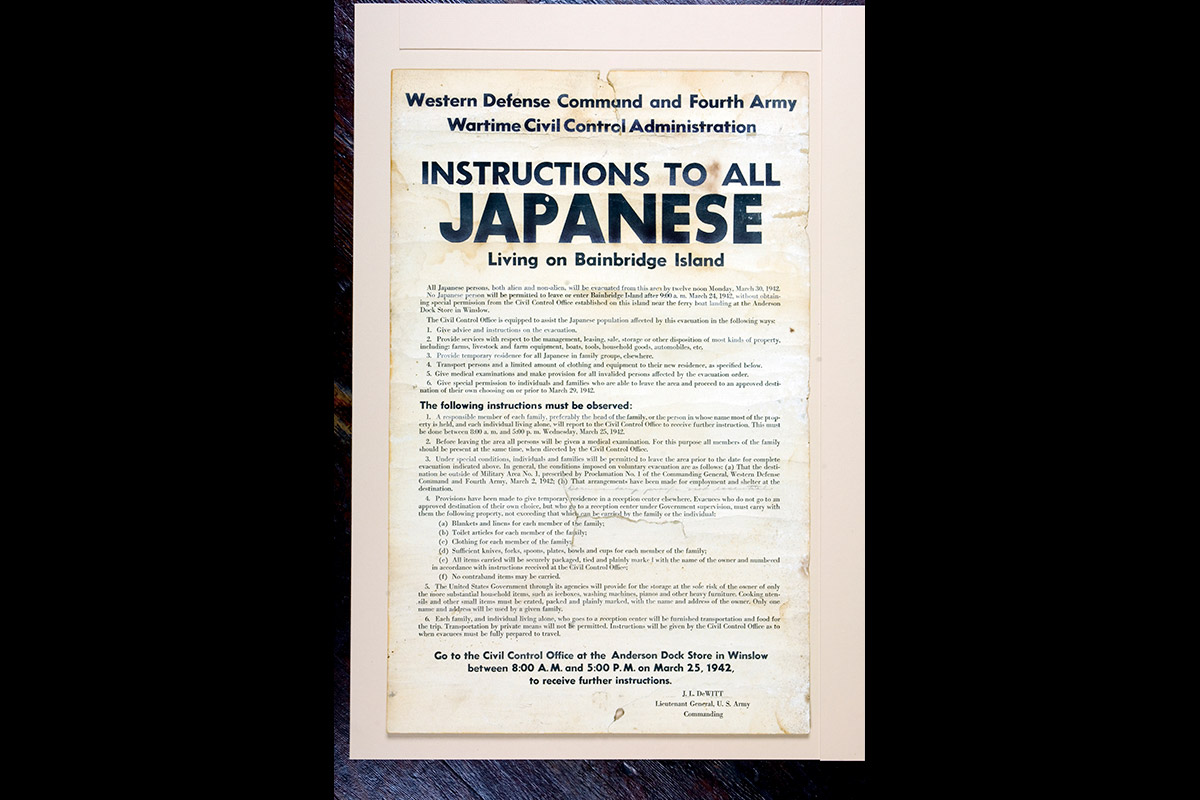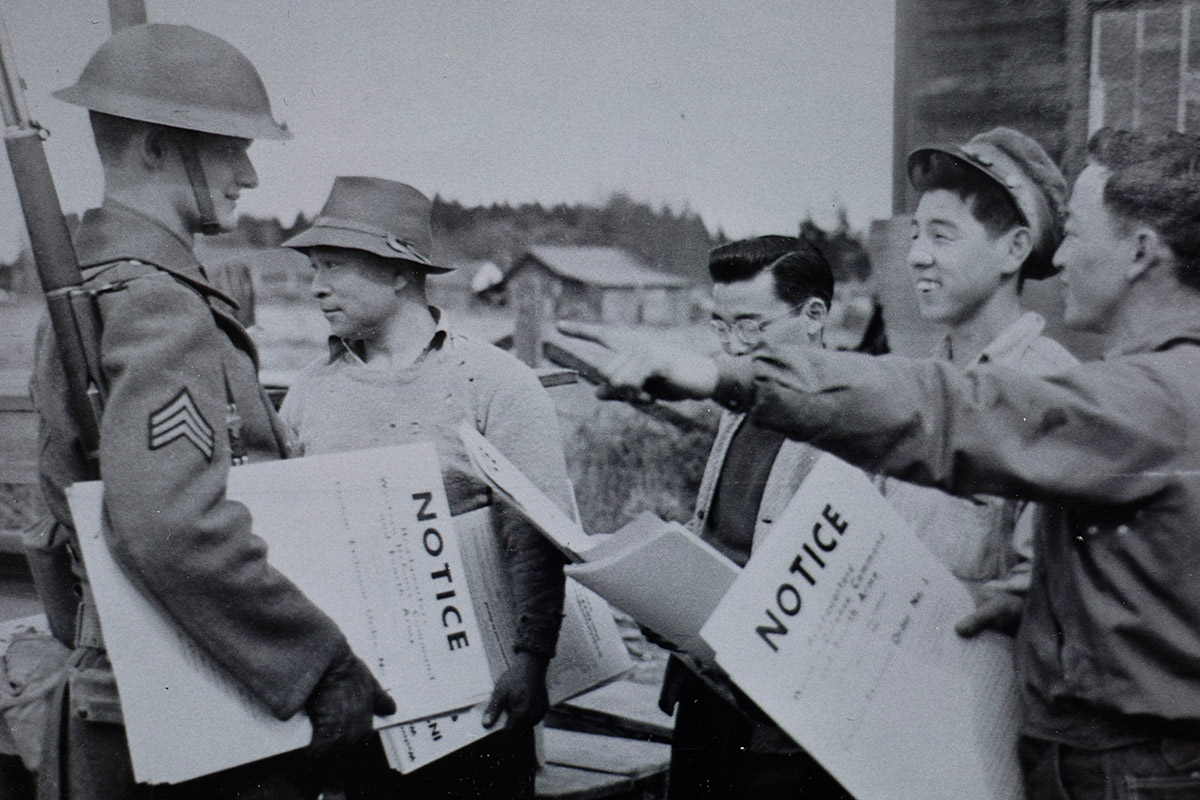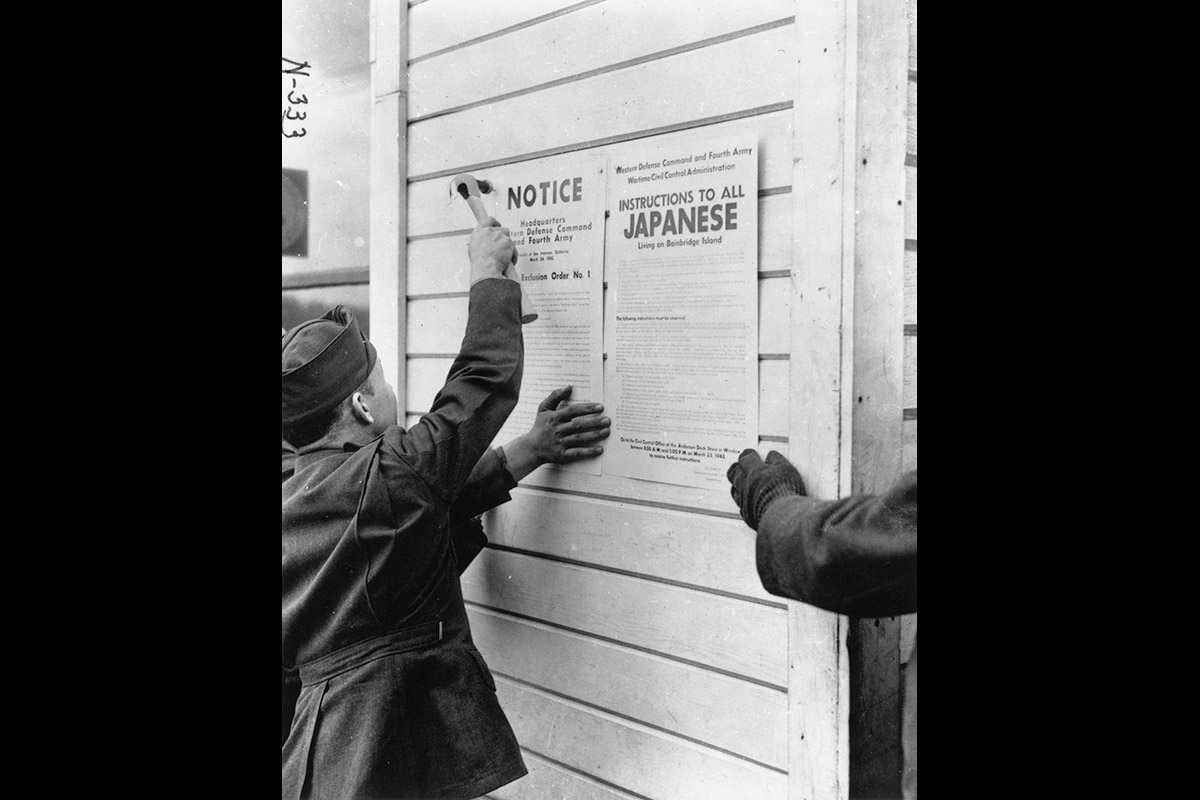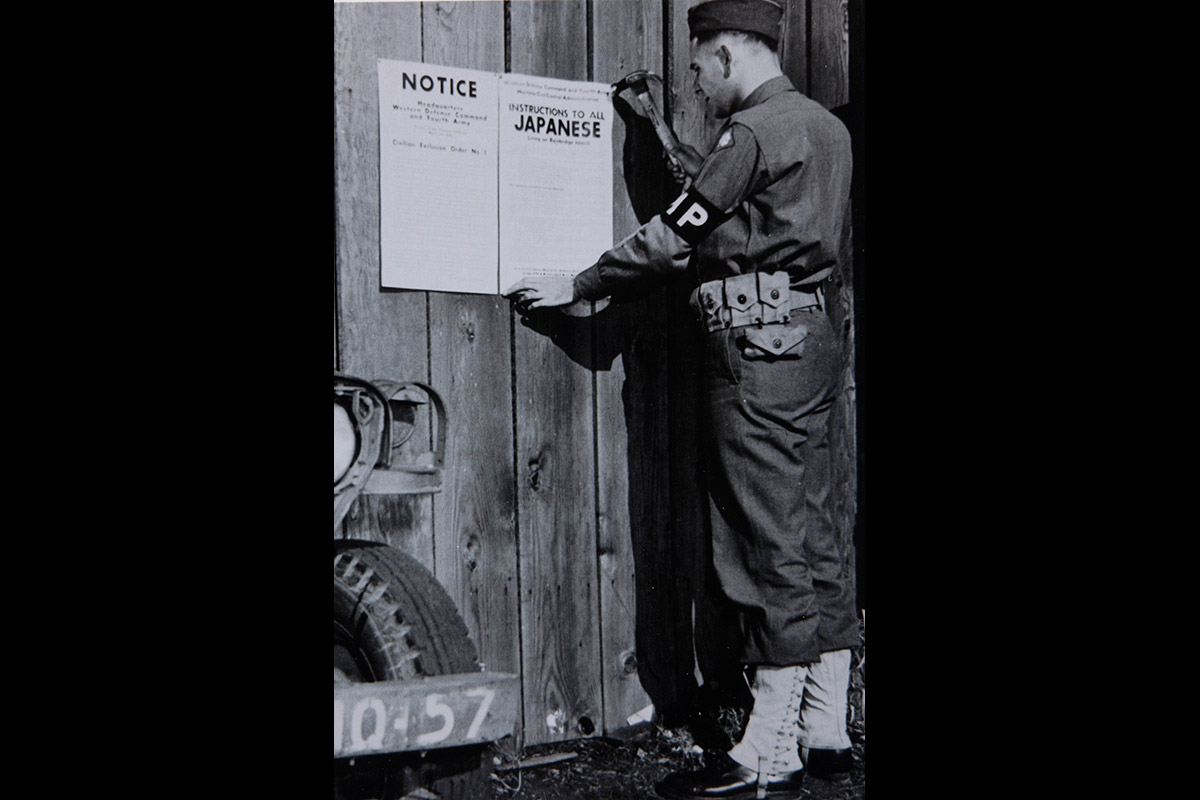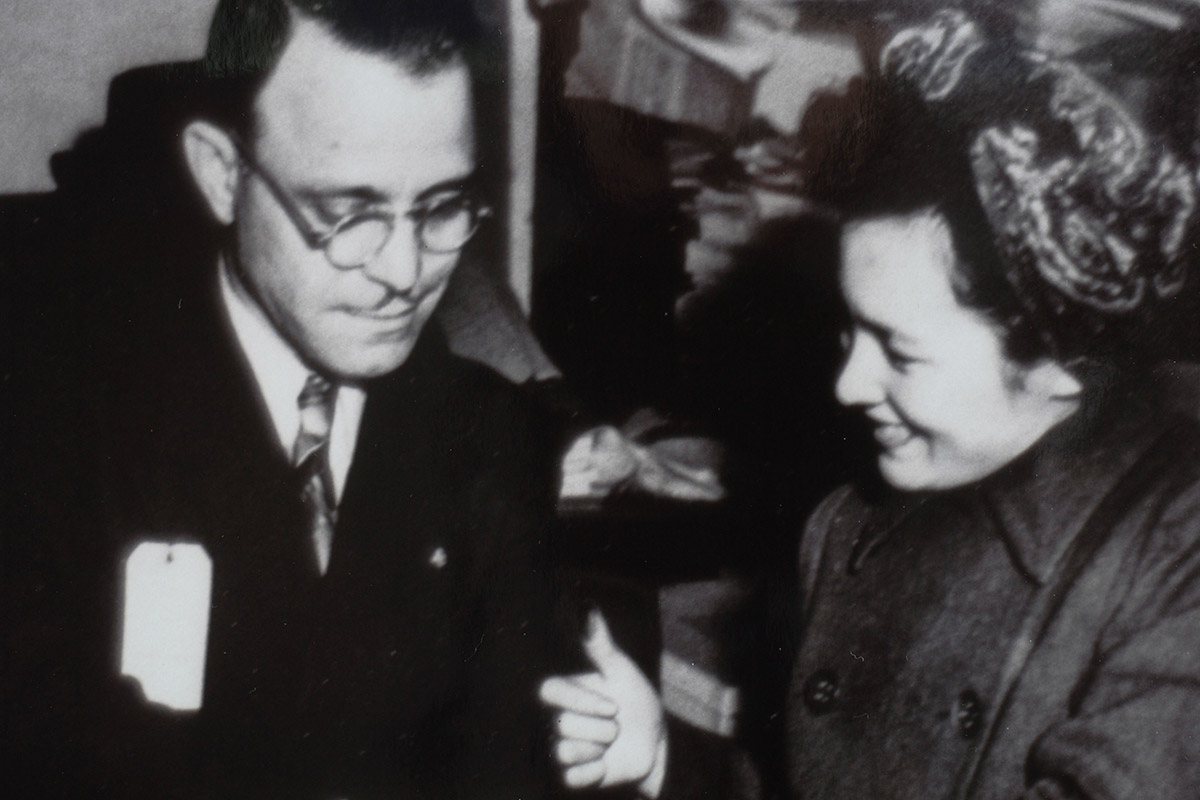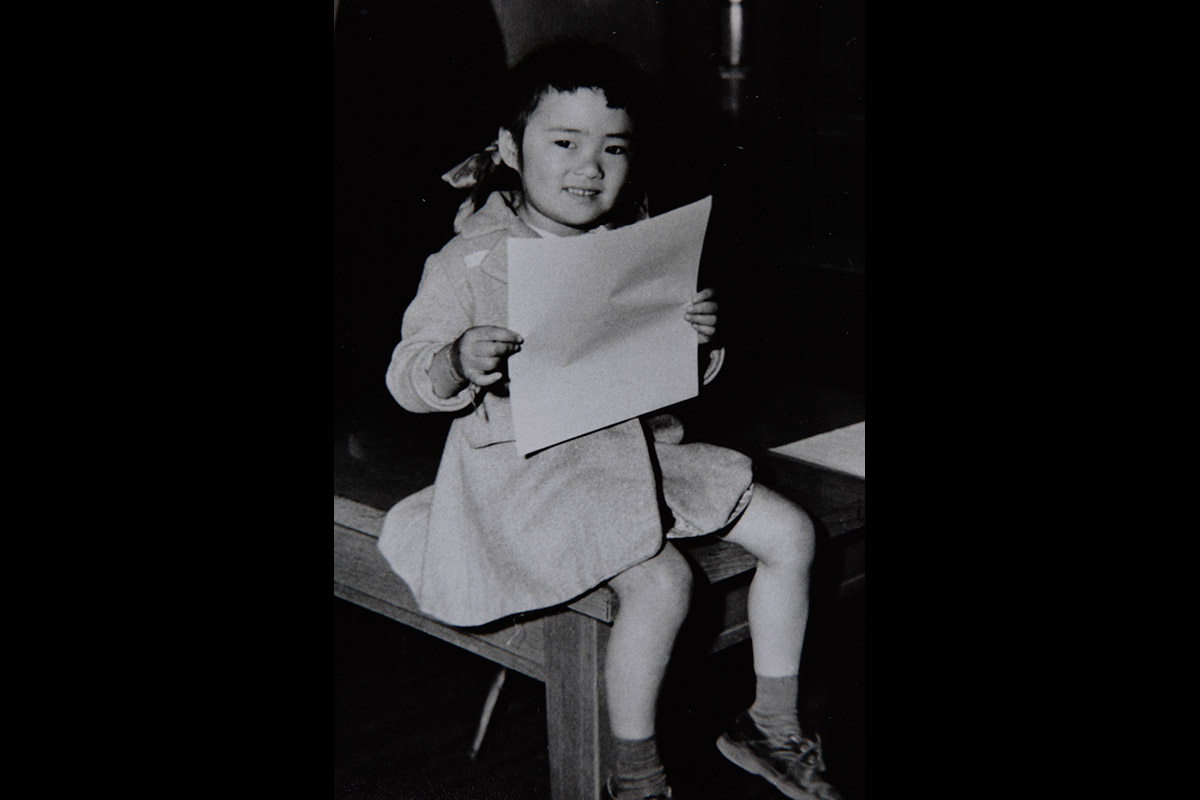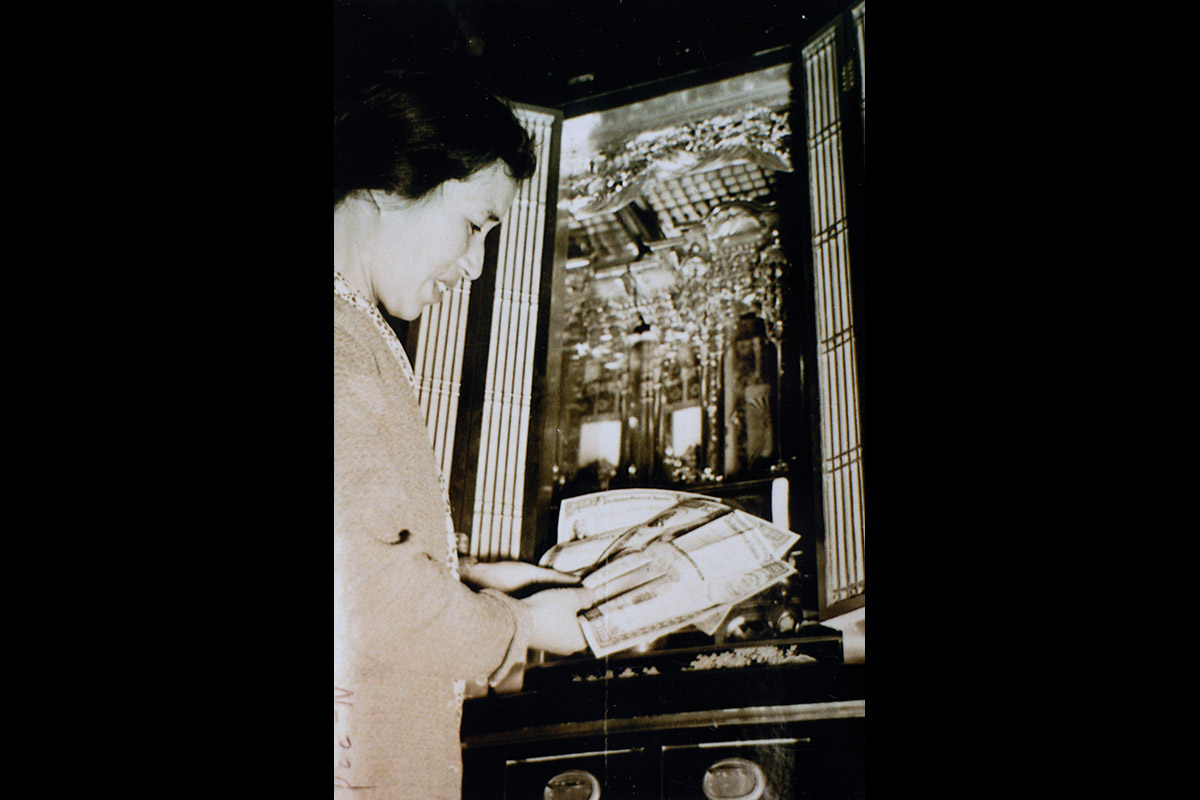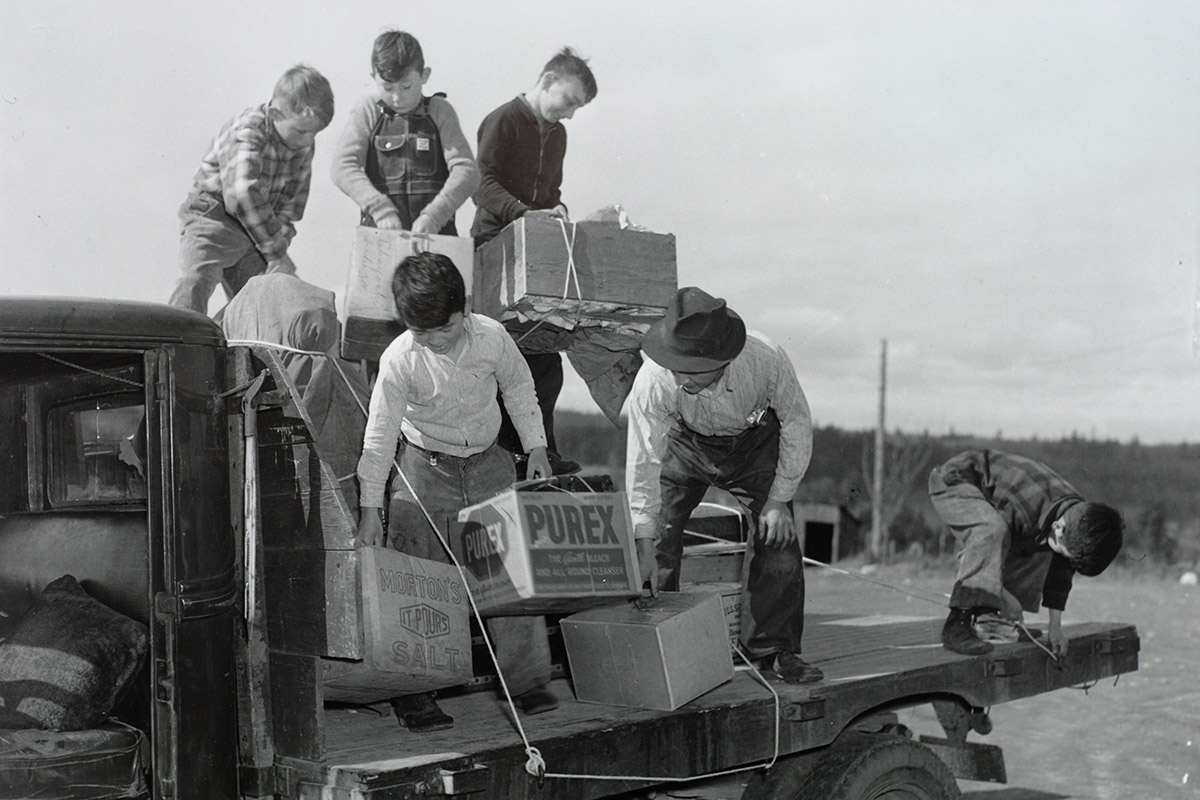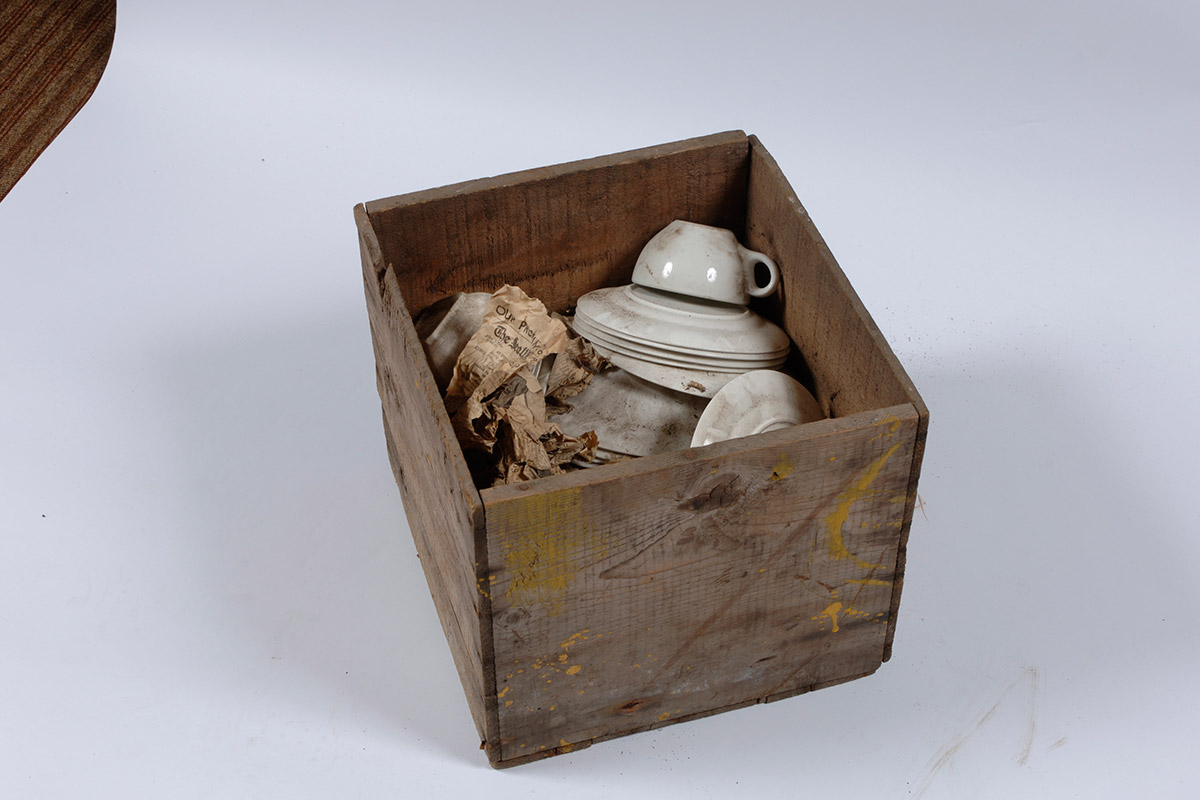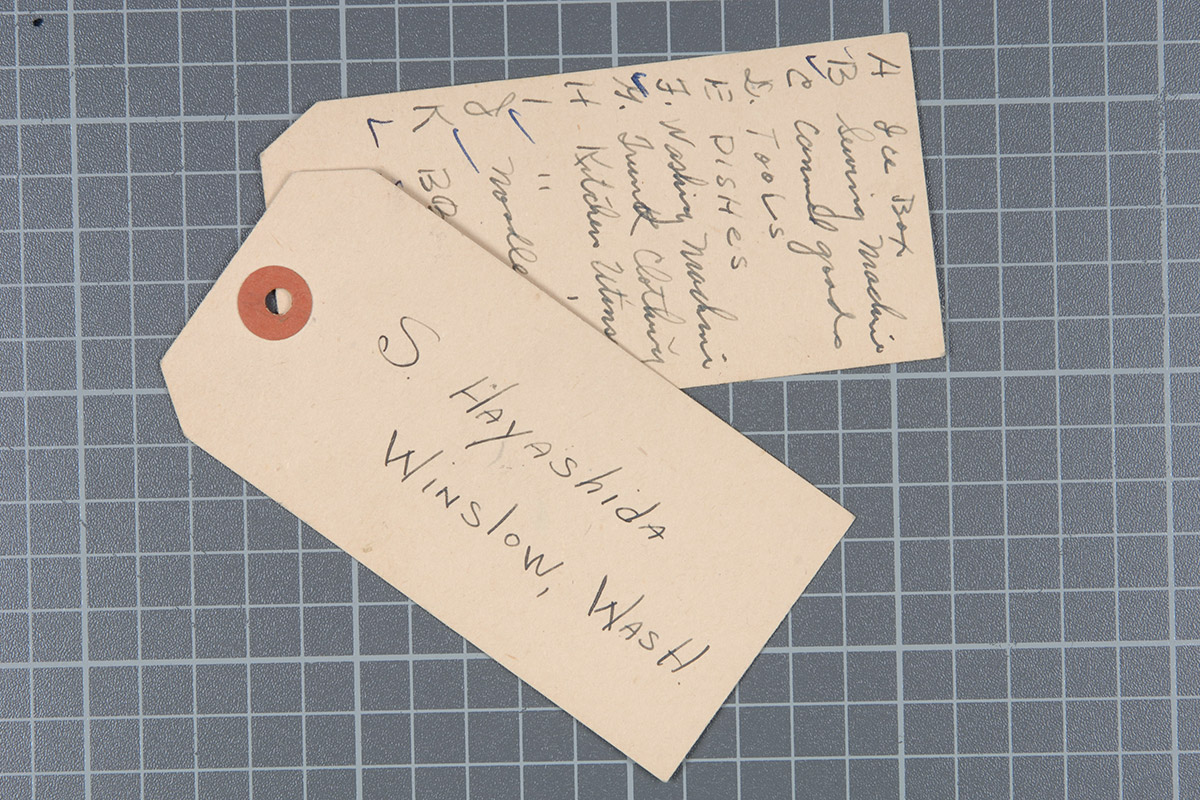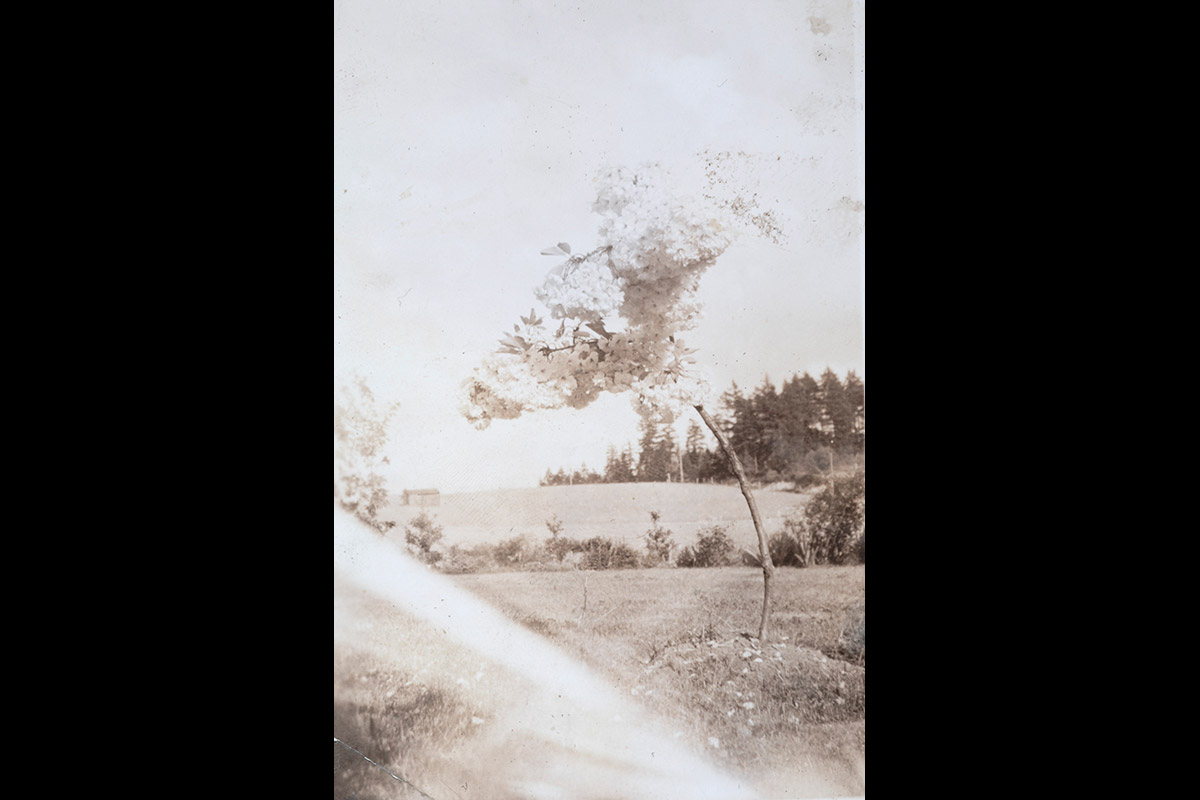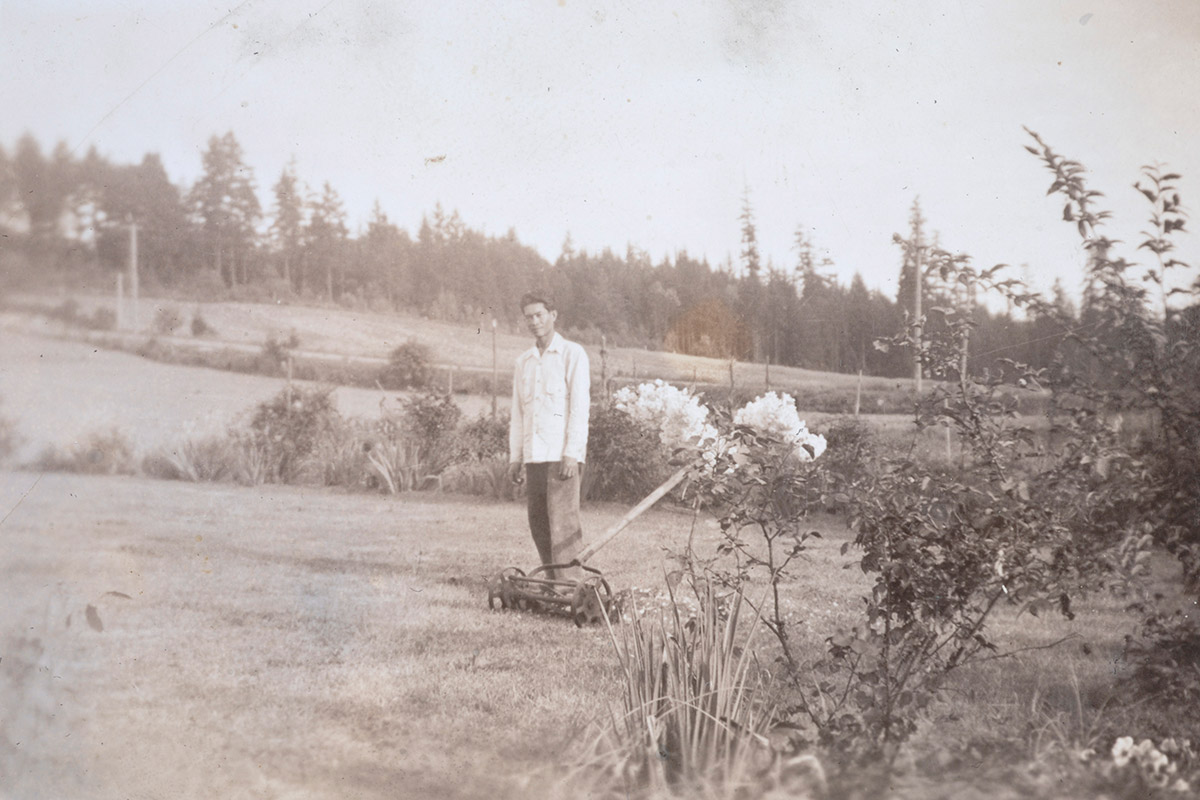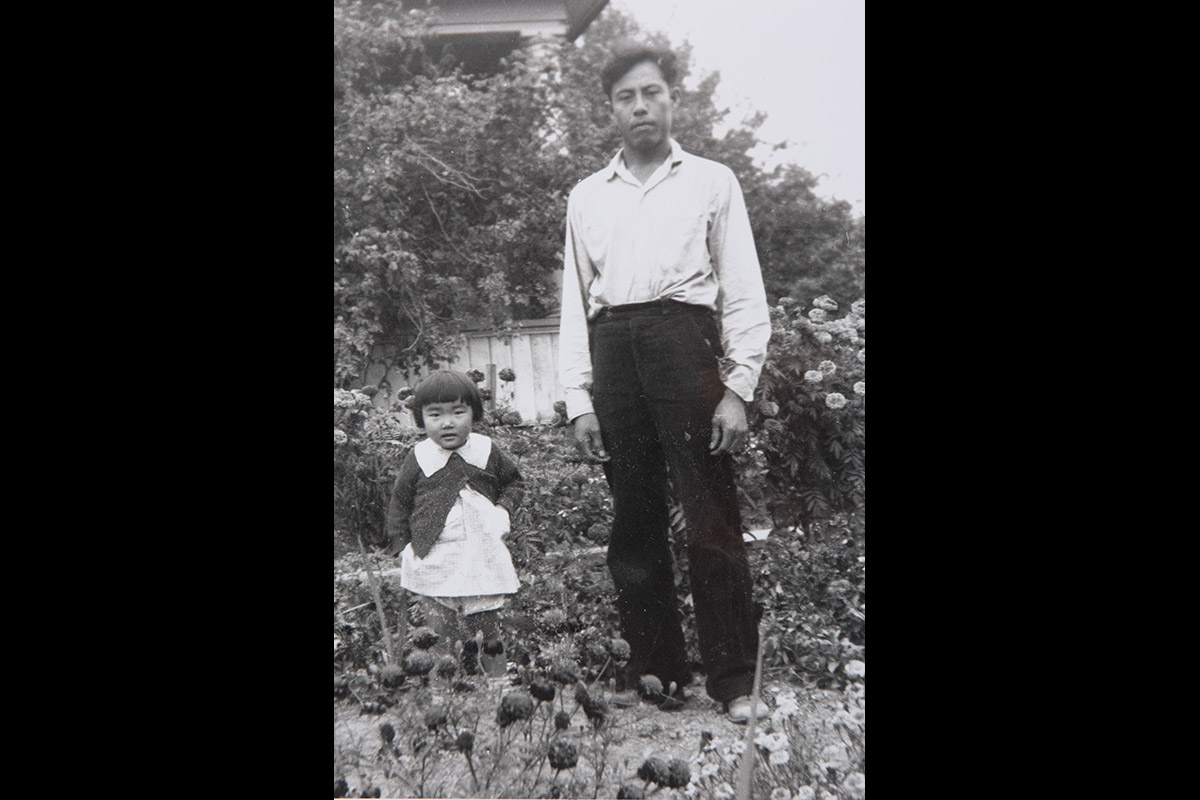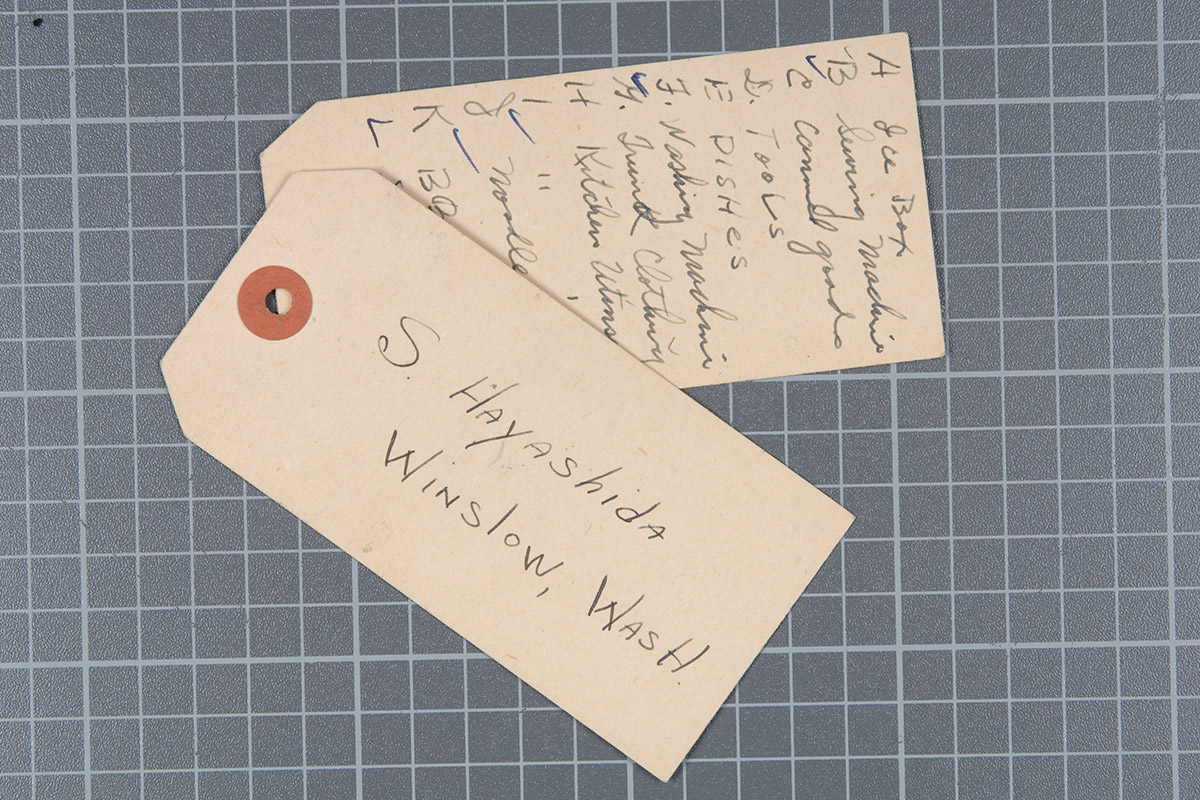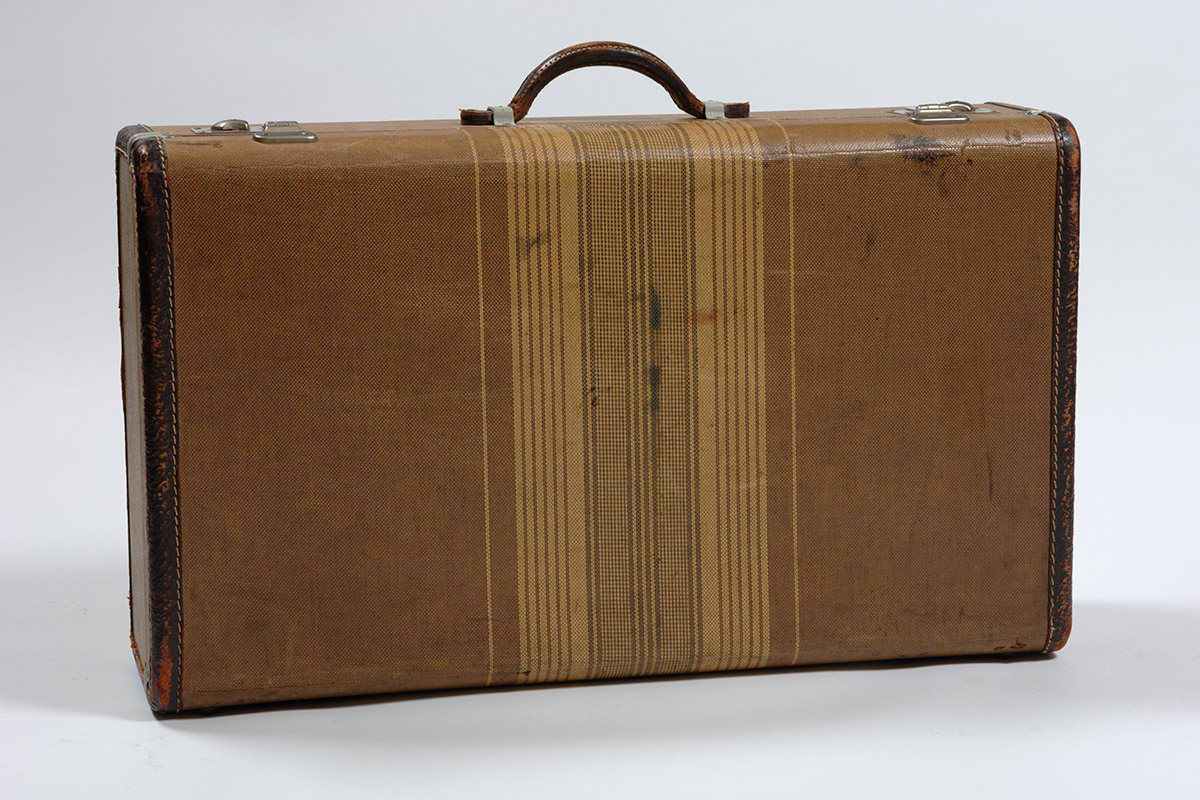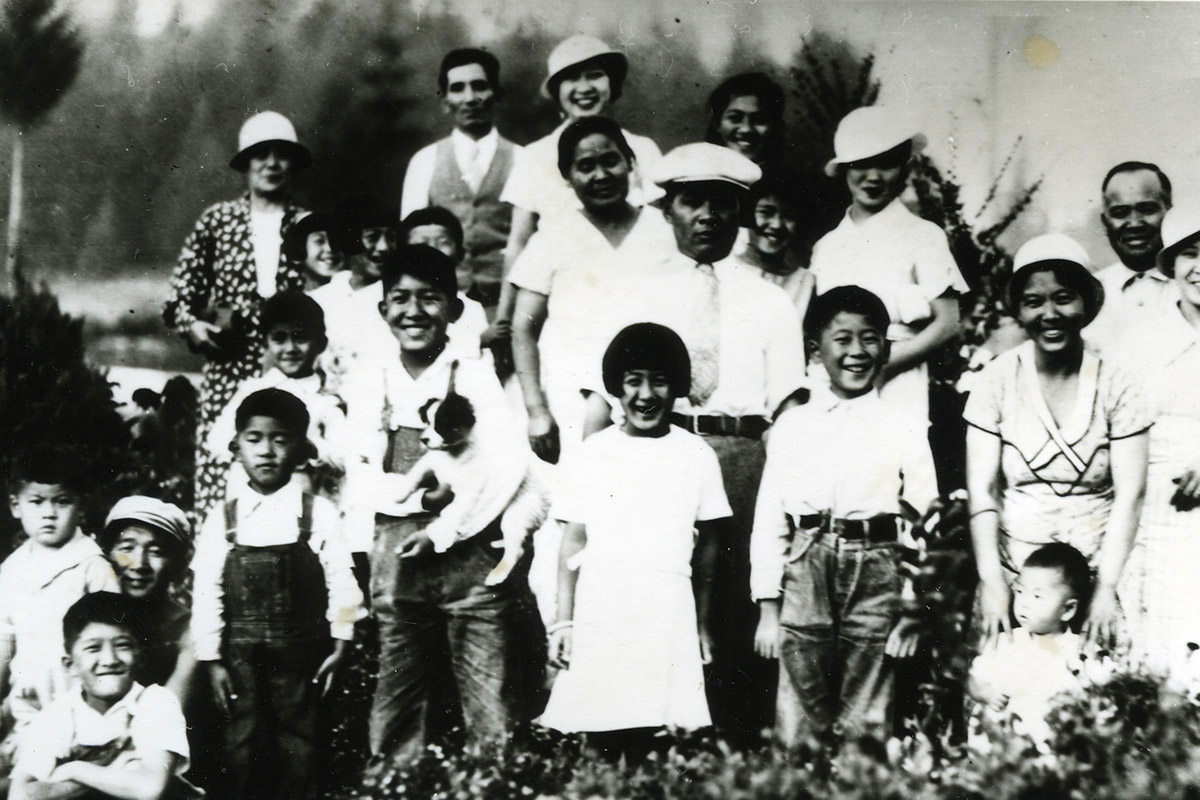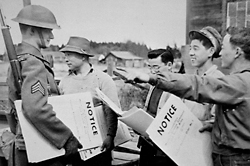
Posting Civilian Exclusion Order No. 1
On February 19, 1942, President Franklin Roosevelt signed Executive Order 9066, allowing for the creation of areas from which "any and all persons may be excluded." His action was unanimously authorized by Congress. FDR designated Lieutenant General J.L. DeWitt as the commander of such areas, thus transferring civilian control from the Justice Department to the army. On March 2, DeWitt issued Public Proclamation No. 1, defining the western portions of Washington, Oregon, and California, and parts of Arizona as areas " with respect to which, the right of any persons to enter, remain in, or leave shall be subject to whatever restrictions" he might impose.
DeWitt had initially allowed families to "voluntarily" move east of the Cascade Mountains. Only three Bainbridge Island families had finalized plans when DeWitt suddenly revoked permission three weeks after the program began. On March 24, Civil Exclusion Order No. 1 was issued, designating Bainbridge Island as the first area from which American citizens and their alien parents would be forced to leave. Islanders were allowed six days to prepare. With the help of neighbors Nikkei families made whatever arrangements they could for their homes, farms, businesses, pets, and belongings.
Slideshow
Many of the families about to be exiled were helped by friends and neighbors as they prepared to leave. Here is an excerpt from Mary Woodward's book In Defense of Our Neighbors describing some of these instances:
"All across the Island, hurried arrangements were also made between the Nikkei and their Caucasian neighbors. Ken Myers, going against specific company instructions, made sure his clients had proper insurance coverage. Clark Burkheimer provided essential legal advice to Nikkei families. Orville Robertson of the Society of Friends agreed to look after some of the less–established farms, thus preserving ownership for the Nikkei. Arnold Raber bought the Koura's farm for one dollar and promised to resell it to them for that price upon their return.
Eve Bucklin stored the Sakais' rugs. The Schmidts took care of the Hayashidas' dishes. The Hydes assisted the Nishimoris. The Burnses helped the Suyematsus. Hakujin (Caucasian) customers settled tabs with local grocer Masaaki "Johnny" Nakata over his protests, saying, "You'll need this."
 All Islanders of Japanese descent were told to report to be registered and what they should pack. There was also notice that anyone could voluntarily move outside of Military Area No. 1 before March 29 as long as they have arranged for employment and shelter. (Credit: Bainbridge Historical Society, George Munro Collection)
All Islanders of Japanese descent were told to report to be registered and what they should pack. There was also notice that anyone could voluntarily move outside of Military Area No. 1 before March 29 as long as they have arranged for employment and shelter. (Credit: Bainbridge Historical Society, George Munro Collection) When army soldiers arrived to post notices of Exclusion Order No. 1, several Nisei arrived to help show the soldiers where the posters should be placed so they would be most visible. Left to right: Unknown soldier, unknown, Takashi Sakuma, Robert Koba, George Chihara. March 24, 1942. (Credit Museum of History and Industry, Seattle Post-Intelligencer Collection)
When army soldiers arrived to post notices of Exclusion Order No. 1, several Nisei arrived to help show the soldiers where the posters should be placed so they would be most visible. Left to right: Unknown soldier, unknown, Takashi Sakuma, Robert Koba, George Chihara. March 24, 1942. (Credit Museum of History and Industry, Seattle Post-Intelligencer Collection) These are special instructions to all Japanese residents of Bainbridge Island, telling them exactly how they are to comply with the evacuation decree. Bainbridge Island was the first area evacuated, presumably because of its proximity to the Puget Sound Navy Yard. (Credit: Library of Congress)
These are special instructions to all Japanese residents of Bainbridge Island, telling them exactly how they are to comply with the evacuation decree. Bainbridge Island was the first area evacuated, presumably because of its proximity to the Puget Sound Navy Yard. (Credit: Library of Congress) As the first community forcibly removed to a concentration camp, Bainbridge Islanders were in effect "guinea pigs" of this mass removal and incarceration effort. (Credit: Library of Congress)
As the first community forcibly removed to a concentration camp, Bainbridge Islanders were in effect "guinea pigs" of this mass removal and incarceration effort. (Credit: Library of Congress) On 3/25/42, all BI Nikkei had to go to the Anderson Dock Store in Winslow on BI to register at the Civilian Control Office. Personal information such as name, age, citizenship, occupation, and spoken language were taken for Nikkei of all ages. Further instructions were also issued at registration. (Credit: Museum of History and Industry, Seattle Post-Intelligencer Collection)
On 3/25/42, all BI Nikkei had to go to the Anderson Dock Store in Winslow on BI to register at the Civilian Control Office. Personal information such as name, age, citizenship, occupation, and spoken language were taken for Nikkei of all ages. Further instructions were also issued at registration. (Credit: Museum of History and Industry, Seattle Post-Intelligencer Collection) Due to the confusion and haste of this time many Islanders had to go to the Civilian Control Office several times to clarify how they were to take care of their personal effects, homes, land, and crops. In the end they received little assistance from the government. (Credit: Museum of History and Industry, Seattle Post-Intelligencer Collection)
Due to the confusion and haste of this time many Islanders had to go to the Civilian Control Office several times to clarify how they were to take care of their personal effects, homes, land, and crops. In the end they received little assistance from the government. (Credit: Museum of History and Industry, Seattle Post-Intelligencer Collection) Yoshiko's husband purchased these war bonds after he cashed in his life insurance policy. This is one example of the many things the Nikkei did to show their loyalty to the United States. She is standing in front of a Buddhist shrine – 3/23/42, BI. (Credit: Museum of History and Industry, Seattle Post-Intelligencer collection)
Yoshiko's husband purchased these war bonds after he cashed in his life insurance policy. This is one example of the many things the Nikkei did to show their loyalty to the United States. She is standing in front of a Buddhist shrine – 3/23/42, BI. (Credit: Museum of History and Industry, Seattle Post-Intelligencer collection) Ben, Henry, and Takato Takayoshi, with the help of some young Caucasian friends, pack belongings onto a pickup truck to be stored during evacuation. Bainbridge Island, WA. 1942. (Credit: Museum of History and Industry, Seattle Post-Intelligencer collection)
Ben, Henry, and Takato Takayoshi, with the help of some young Caucasian friends, pack belongings onto a pickup truck to be stored during evacuation. Bainbridge Island, WA. 1942. (Credit: Museum of History and Industry, Seattle Post-Intelligencer collection) This china was used in the Japanese Hall on Grow Avenue, Bainbridge Island, WA. It was stored in the Moritani barn during exclusion.
This china was used in the Japanese Hall on Grow Avenue, Bainbridge Island, WA. It was stored in the Moritani barn during exclusion. Many household items had to be hastily packed for storage such as these cups that were used in the Japanese Social Hall on Grow Avenue, Bainbridge Island.
Many household items had to be hastily packed for storage such as these cups that were used in the Japanese Social Hall on Grow Avenue, Bainbridge Island. The government had a local warehouse where Bainbridge Islanders could store boxes and large items such as refrigerators or sewing machines while they were exiled. This is a tag placed on one of Saburo Hayashida's boxes. At the end of the war Saburo had sixty days to retrieve these items or they would forfeited.
The government had a local warehouse where Bainbridge Islanders could store boxes and large items such as refrigerators or sewing machines while they were exiled. This is a tag placed on one of Saburo Hayashida's boxes. At the end of the war Saburo had sixty days to retrieve these items or they would forfeited. This cherry tree was planted by the Hayashidas just prior to evacuation.
This cherry tree was planted by the Hayashidas just prior to evacuation. Johnnie and several other Filipino American bachelors stayed in the Hayashida family home on High School Road and looked after their land. During the war Johnny took this photo of himself standing in their front yard and mailed it to Minidoka to assure the Hayashidas all was well back home.
Johnnie and several other Filipino American bachelors stayed in the Hayashida family home on High School Road and looked after their land. During the war Johnny took this photo of himself standing in their front yard and mailed it to Minidoka to assure the Hayashidas all was well back home. Elaulio and his cousin Felix Narte looked after the Kitamoto property and home during the war. Many Nikkei farmers partnered with their trusted Filipino foremen to harvest the last crop and look after the farms during the war. It was because of these relationships that most of the Islanders who owned land had something to return to after the war.
Elaulio and his cousin Felix Narte looked after the Kitamoto property and home during the war. Many Nikkei farmers partnered with their trusted Filipino foremen to harvest the last crop and look after the farms during the war. It was because of these relationships that most of the Islanders who owned land had something to return to after the war. Prior to evacuation, R.G. Dennis, principal of Bainbridge Island High School, helps a group of Japanese students to transfer their credits to Manzanar in preparation for leaving school for evacuation. L to R: Principal Dennis, Tats Kojima, Isamu Suyematsu, Hideaki Nakamura. (Credit: Library of Congress)
Prior to evacuation, R.G. Dennis, principal of Bainbridge Island High School, helps a group of Japanese students to transfer their credits to Manzanar in preparation for leaving school for evacuation. L to R: Principal Dennis, Tats Kojima, Isamu Suyematsu, Hideaki Nakamura. (Credit: Library of Congress) This is an example of a suitcase that may have been used during evacuation. Each evacuee was allowed to carry only one piece of luggage. Many Bainbridge Islanders did not own a suitcase and had to travel to Seattle to purchase one. This was only one of the many tasks they had to complete in six days.
This is an example of a suitcase that may have been used during evacuation. Each evacuee was allowed to carry only one piece of luggage. Many Bainbridge Islanders did not own a suitcase and had to travel to Seattle to purchase one. This was only one of the many tasks they had to complete in six days. These three families were able to move outside of Military Area No. 1 by arranging to farm east of the Cascade Mountains in Moses Lake, Washington. It took quick planning and their savings to make this happen in the short three-week window allowed by the US government. They remained there throughout the war. Here they are gathered for a family picnic circa 1935-40. (Credit: Bainbridge Island Historical Society, Junkoh Harui Collection)
These three families were able to move outside of Military Area No. 1 by arranging to farm east of the Cascade Mountains in Moses Lake, Washington. It took quick planning and their savings to make this happen in the short three-week window allowed by the US government. They remained there throughout the war. Here they are gathered for a family picnic circa 1935-40. (Credit: Bainbridge Island Historical Society, Junkoh Harui Collection)
Oral History
- Help from Friends of Alliance Church - Michi Noritake (OH0007)
- Family prepares to leave - Vic Takemoto (OH0014)
- New home, destroyed Japanese things - Kay Nakao (OH0018)
- Chaos, storage and loss, packing and what to wear - Kay Nakao (OH0019)
- JACL meetings, preparing to leave, arrangements for house and farm - Yae Yoshihara (OH0035)
- Why BI first, why cooperated - Frank Kitamoto (OH0043)
- Shigata ga nai or "it cannot be helped" - Hisa Matsudaira (OH0051)
- Moneybelts - Nobi Omoto (OH0053)
- Help from Filipino friends - Lilly Kodama (OH0055)
- Registering - Matsue Watanabe (OH0062)
- Packing and what students think - Matsue Watanabe (OH0063)
- Had to leave doll behind - Sally Kitano (OH0075)
- Walt gives advice to some Nisei - Mary Woodward (OH0085)
- What if Niseis said, "No, we won't go" - Sada Omoto (OH0092)
Photo Information: Posting Civilian Exclusion Order No. 1 — When army soldiers arrived via ferry to post notices of Exclusion Order Number One, several Nisei or second generation men arrived to help show the soldiers where the posters should be placed so they would be most visible. Left to right: Unknown soldier, possible young issei, Takashi Sakuma, Robert Koba, George Chihara. Bainbridge Island, WA March 24, 1942. Seattle PI photo N331. Library of Congress

